
 |
Previous | SkunkHaven.Net Index | Next |
| Page 1 | Page 2 | Page 3 | Page 4 | Page 5 | Page 6 | Page 7 | Page 8 | Page 9 | Page 10 |
We have begun a repository of information on traditional and non-traditional veterinary care for skunks. We, along with several veterinarians, are collecting information on procedures, techniques, drugs, etc., used for skunks.
Most of the information in our pages on vet care are intended for veterinarians, animal caregivers, and pet rescue organizations. These pages have photos and data tables which will have limited use for persons with disabilities or anyone using a text-only web browser.
We have been identified as a client resource by Exotic DVM Magazine.
Exotic Veterinary Magazine has written a "Unusual Pet Care Manual " . We are referenced in the skunk care section. To buy the book please go to www.exoticdvm.com.
An excellent resource for veterinarians can be found at www.PubMed.gov.
A paper from Journal of Wildlife Diseases, regarding Renal Lesions in Striped Skunks.
A paper from Journal of Wildlife Diseases, regarding Toxoplasmosis, Distemper, and Herpesvirus Infection in a Skunk.
Dr. Frank Krupka at Avon Lake Animal Clinic, Avon Lake, OH, 440-933-5297 may be contacted for questions or if you wish to add information to our database.
Vets are encouraged to send us photos and text descriptions of unusual health care issues that they observe in skunks. Information may be presented in Skunk News and posted to these Vet Care pages.
We recommend giving distemper/parvo shots every two years using Schering-Plough Galaxy DA2PPv. Other vaccines (Fer-Vac, Fort Dodge brands, and others) have been known to cause adverse reactions or other problems requiring veterinary care. Feline shots are not recommended. Do not over vaccinate a skunk!
Warning! Some skunks have had adverse reactions to vaccines from personality changes to being sick, sometimes not eating and sometimes death.
THERE ARE NO APPROVED RABIES VACCINES FOR SKUNKS. Under
these circumstances we do NOT recommend giving rabies shots.
Rabies shots will NOT prevent the health department from taking
a skunk if it bites someone.
Rabies DNA
Test: www.dyneimmuneinstitute.com/strategy.html
02/03/09 - Rabies RAPID(TM) (Rapid Antibody Portable Immunodetection)
Screen detects the virus' antigen in saliva and indicates a positive
result in the low microgram-per-milliliter range. A simple results window
in the screening kit indicates within minutes whether an animal is infected with
rabies. The test is packaged in a small, lightweight kit that can be used both
in the field and in the lab as a primary screening tool.
"This test can reduce the number of animals
destroyed and save doctors and
animal control organizations
from the costs associated with traditional testing," said Dyne Immune CEO, Dr.
V. James DeFranco, MD. "Most importantly, though, it enables them to screen for
rabies and get an answer quickly
$150.00 per
5 tests Test once a week
94% Accurate
Contact: Michael Huchital, PhD,Dyne Immune, LLC
845.987.9878, (845) 986-5268, (859) 918-1561 info@dyneimmune.com
Skunks should be neutered between 4 and 6 months of age depending on weight and health. Failure to do so can cause behavior problems, can be extremely stressful, and can cause health problems for the skunk. Some female skunks suffer from systemic infections and general poor health during the breeding season (beginning in late January), these problems can be decreased or eliminated by spaying the skunk.
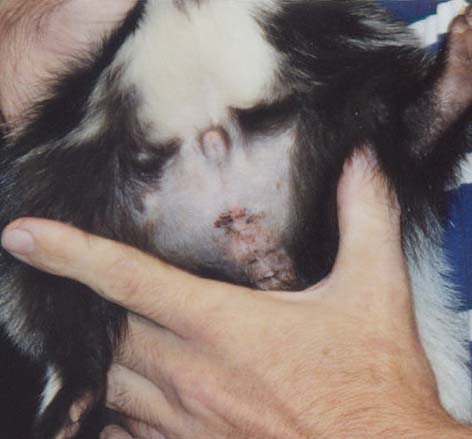 |
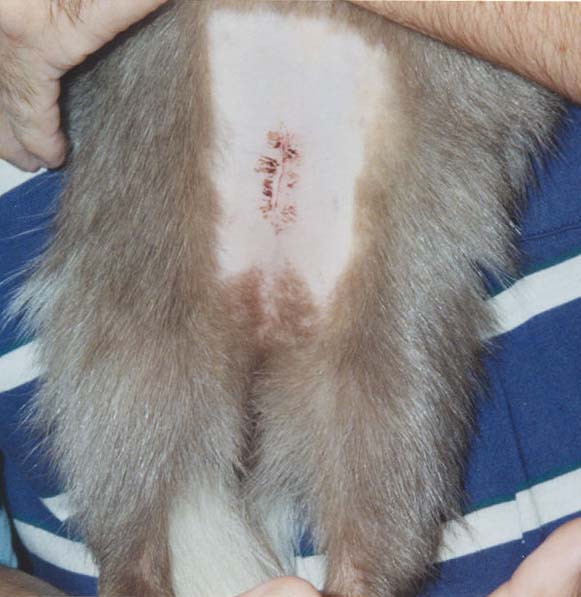 |
| Male Neuter - One Day After | Female Spay - One Day After |
We recommend using isoflurane gas for anesthetic when doing surgery.
Surgical glue has performed well to secure wounds and prevents unnecessary scratching and infection. The skunks are less likely to scratch and/or pull at the incision when glue is used.
A worming regimen is recommended, especially prior to surgery whenever
possible. Skunks should be wormed with a safe wormer like Pro-Wormer-2 ®, Strongid, Nemex-2 ®, or Panacur. Information
on common wormers used on skunks.
Note: Wormers containing piperazine
(piperazine citrate) have caused tremors, seizures, vomiting, and have been
indicated as factors in several deaths, in skunks. Erliworm is a common brand of pet wormer containing
piperazine.
Health problems in skunks include rectal prolapse, seizures, diabetes, liver disease, kidney failure, heart problems, calcium deficiency, excessive weight, allergies, general mal-nutrition, etc. With proper care most of these can be corrected BEFORE the problem starts.
If you skunk stops pooping, starts to vomit, stops eating your skunk may have Intussusception.
Rush your skunk to the vets for an x-ray to see if this is the problem. It will not corret itself and most of the time death happens.
I know of a few skunks this has happen to. For the ones that this was caught in time surgery was done and was healed.
Read about it ⇒ http://www.peteducation.com/article.cfm?c=2+1571&aid=307
It has been reported
that several skunks have died while on Metacam.
One skunk was only 3.5
years old and just had a limp, was eating fine. While on the
metacam the skunk showed a reaction but vet said it was normal.
The skunk died within the week of treatment on
this drug. We do urge skunk owners to have your vet find
another safer drug to use on your skunk.
You can use
Torbutrol.
Here's a web
site with the warning to look at
http://www.ehow.com/about_5300091_side-effects-metacam-dogs.html
http://www.fda.gov/AnimalVeterinary/NewsEvents/CVMUpdates/ucm231254.htm
This site
tells about the rupture of the stomach
|
To calm your pet you can use Calms Forte', Rescue Remedy, Valerian Root and you can spray lavender oil around the bedding |
Some skunks exhibit various forms of alopecia.
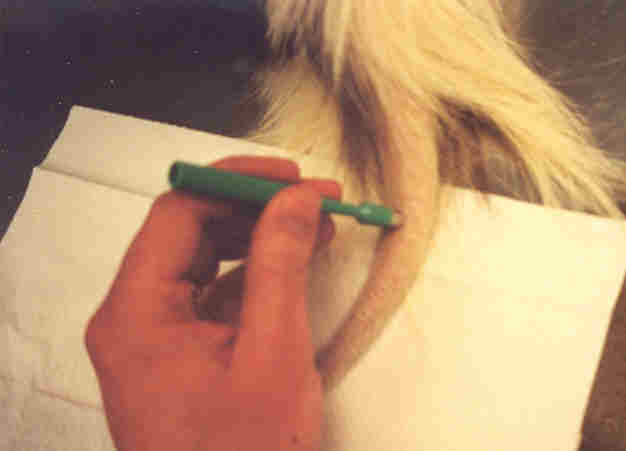 |
This skunk's tail indicates a typical alopecia with varied regrowth noted at the time the biopsy was done. Lab results found no mites or other signs of parasites and little inflammation of the skin. Expected causes include endocrine imbalances, seasonal, and nutritional causes. |
| Biopsy of tail, 0.5 cm skin punch | Photo by Dr. F Krupka, DVM |
Some of these cases have responded to simple daily cleaning with mild detergent or a daily rinse with mineral water.
For some unknown reason some skunks (most of which are over weight) get a fat deposit in the corner of their eyes or under the eyelids. At this time we have not analyzed this nor do we know why skunks get this.
 |
Here we show a fatty deposit near the eye in an older skunk. Photo by Deb Cipriani |
Skunks have had allergic reactions to various chemicals, including bleach and other cleaning products.
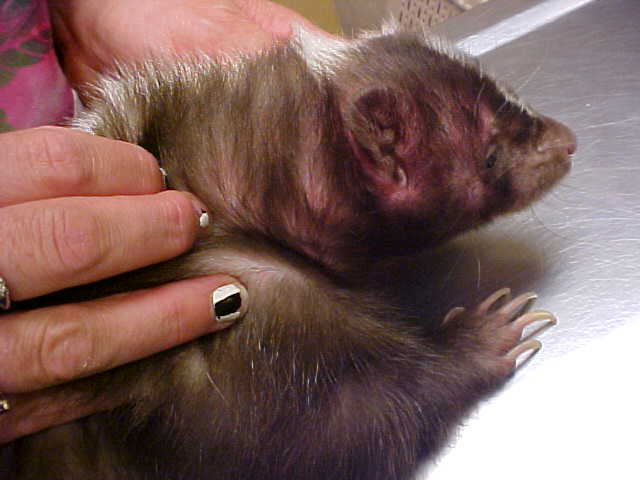 |
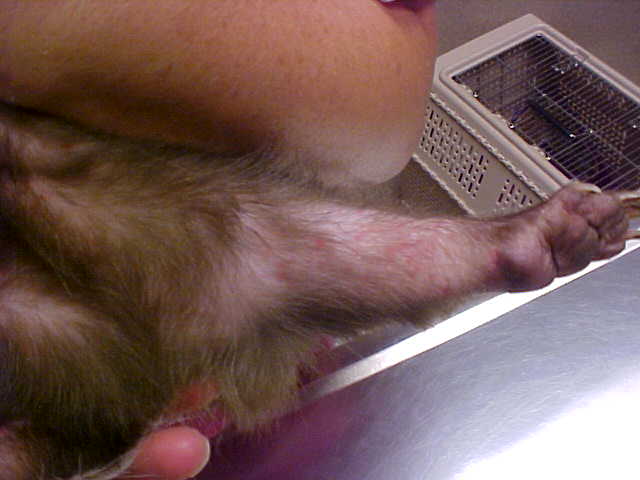 |
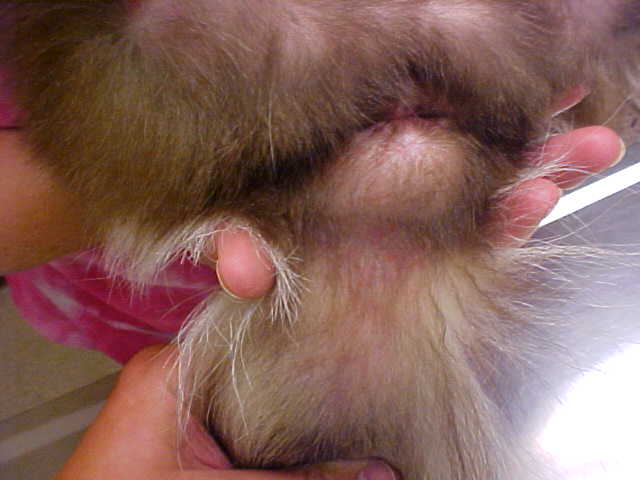 |
Skunk with noticable signs of reaction to bleach. This reaction was initially triggered by the skunk sleeping in bedding that had been washed with bleach and (it appears) not rinsed properly. Subsequently similar reactions have been seen on this skunk after only smelling bleach fumes. |
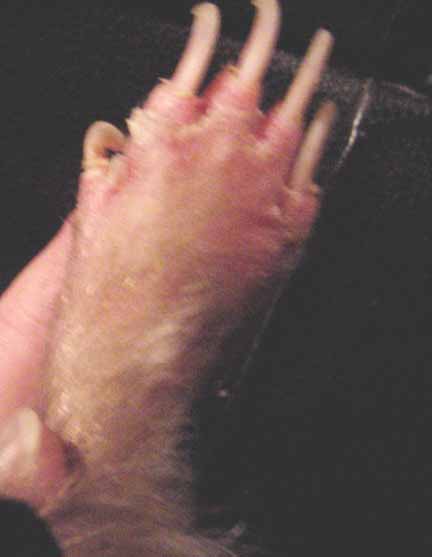 |
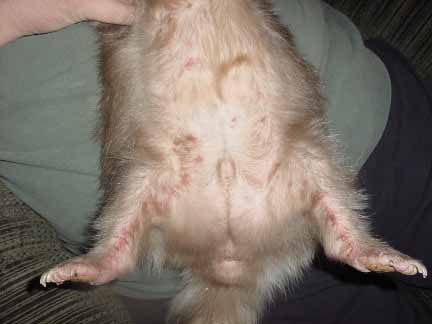 |
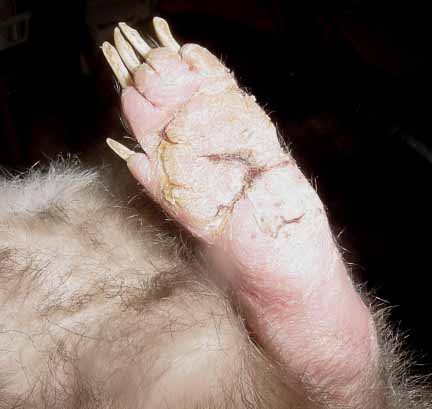 |
Another skunk with severe reaction to cleaning chemicals. |
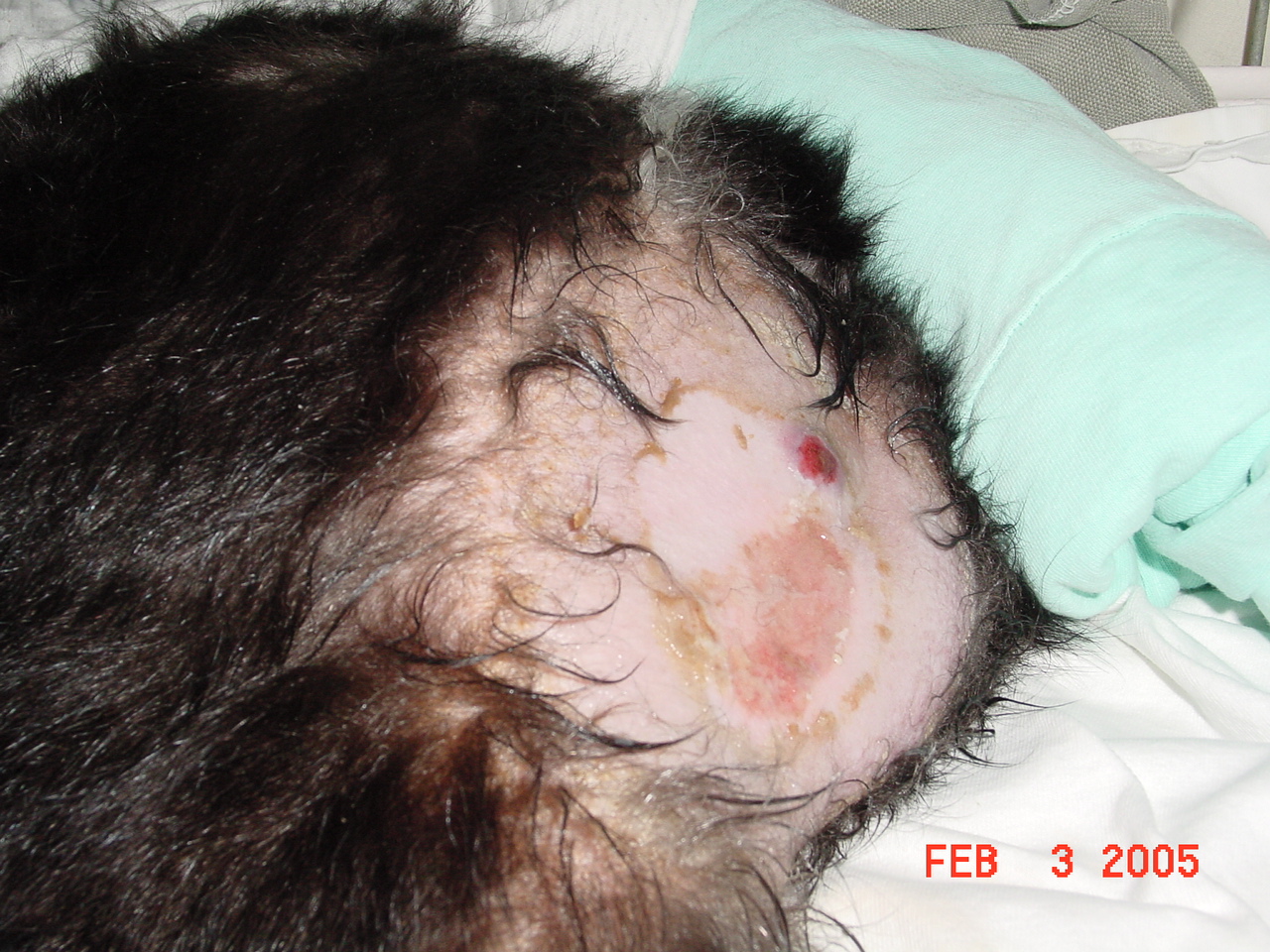 |
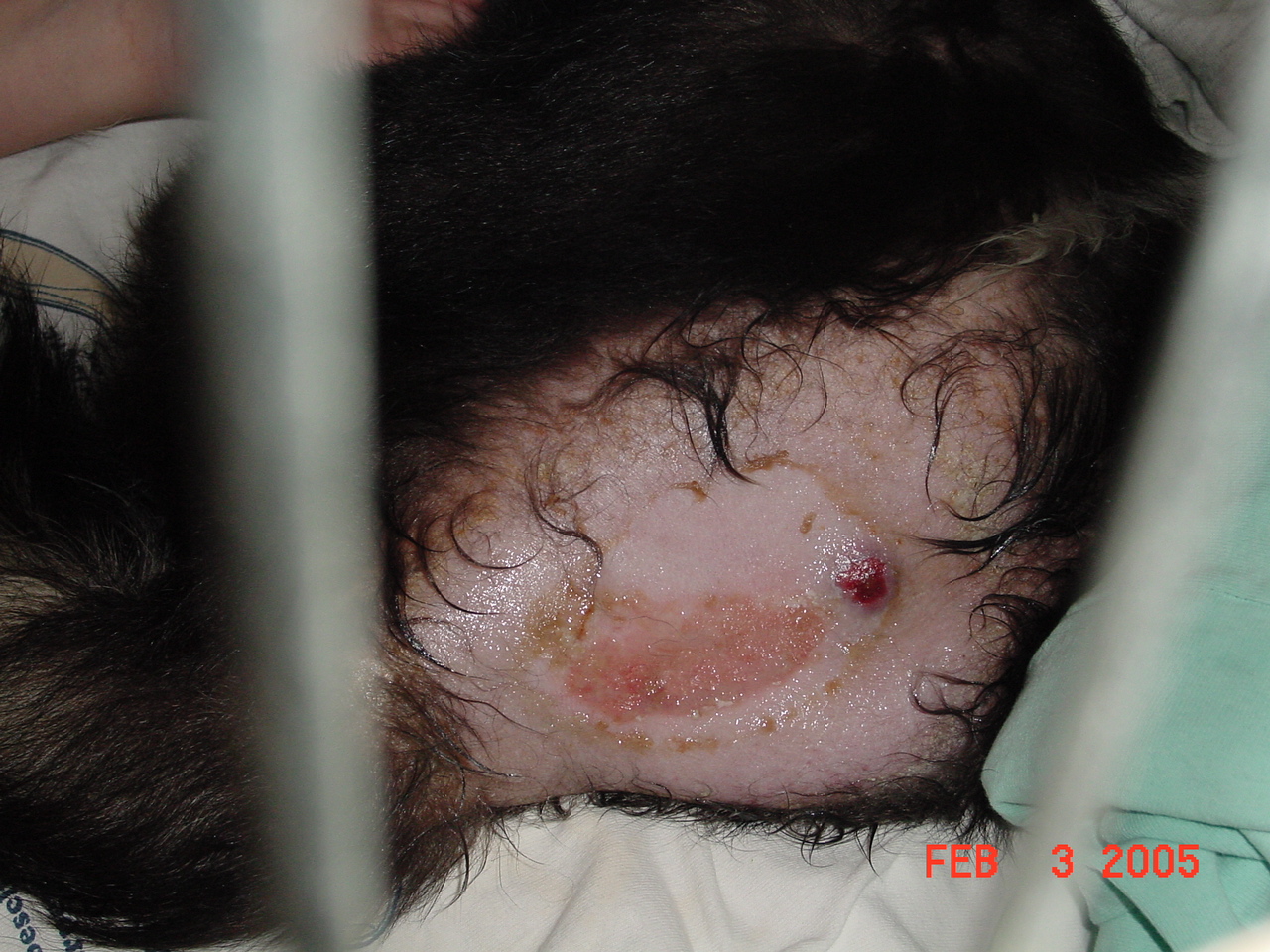 |
| Photos by Dr. M. Luper, DVM | |
Occasionally skunks will self-mutilate thier tails, feet, etc. The causes of this are inconclusive or vary greatly, in many cases skunks have had to be euthanized.
We have a skunk in care that wasn't raising her tail and was showing other signs that there was something wrong with her hips or back legs. X-rays showed just a little arthritis and we began our typical treatments. Within a week of the x-rays she started to chew the end of her tail and scream from the pain as she did so. She had chewed off over an inch of the end of her tail.
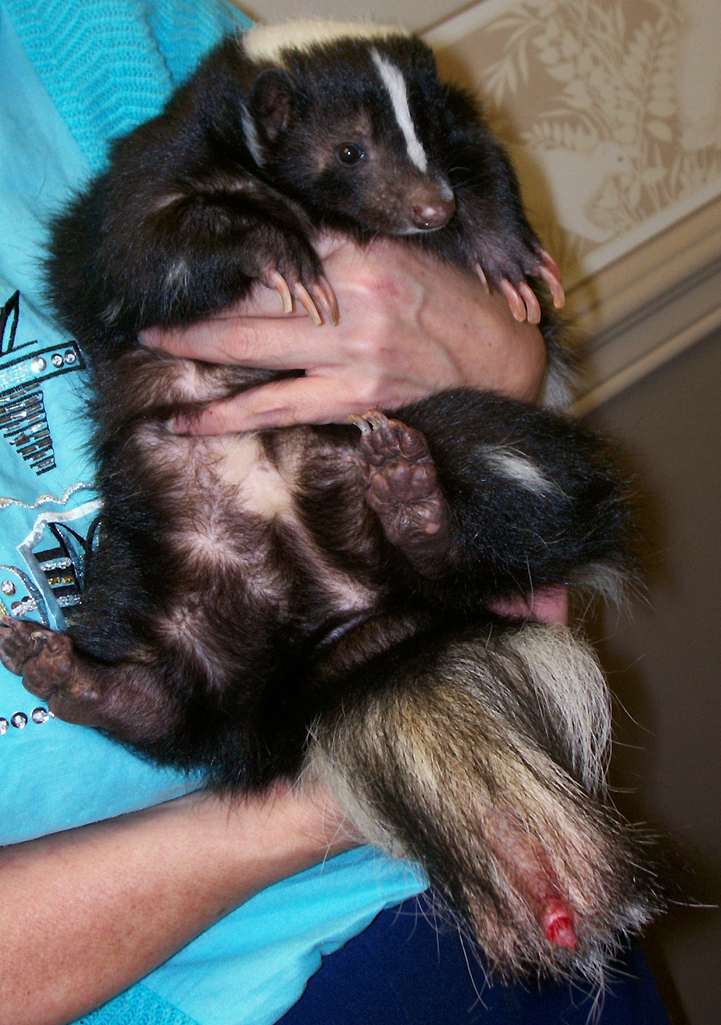 |
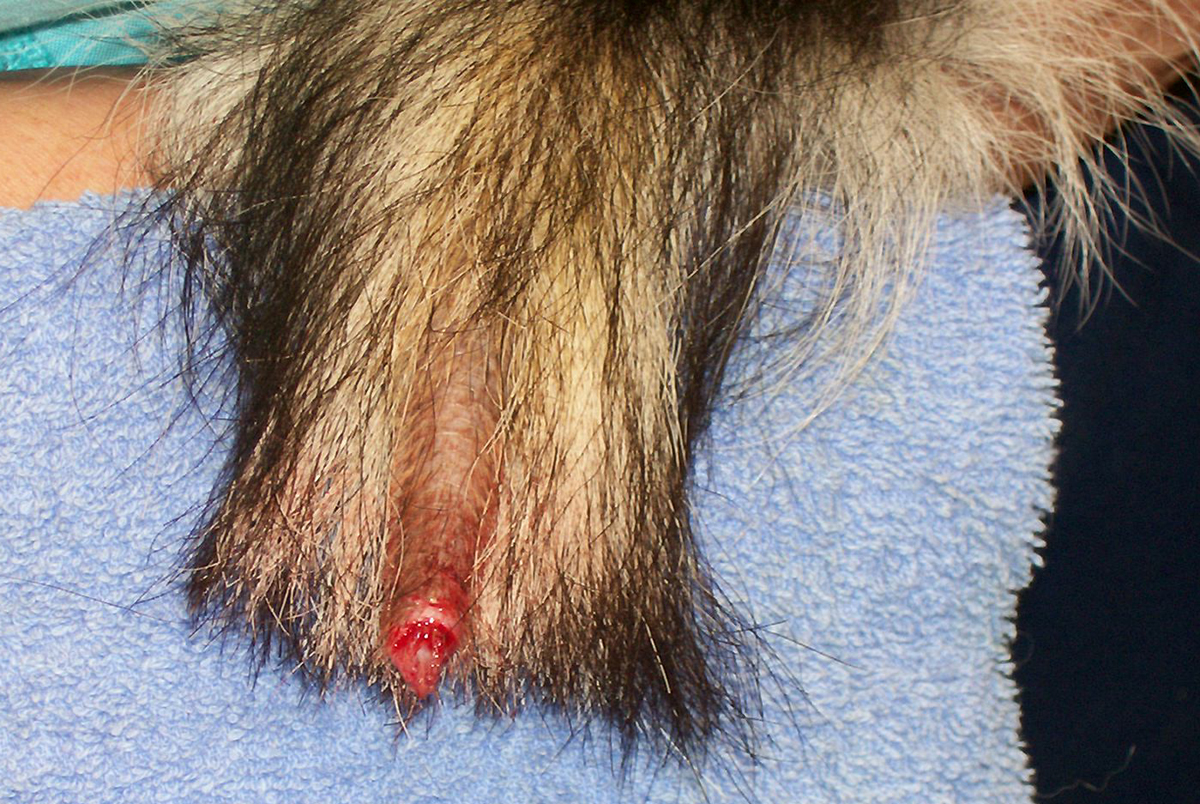 |
| Photos by Deb Cipriani | |
We were willing to try anything to help her because if she would not stop we knew the outcome. She was put on Rimadyl and Amitriptyline (common anti-depressant used on pocket pets that self-mutilate and cats that have problems associated with depression or anxiety) and prayed. Her tail-biting episodes stopped immediately with this treatment. After about a week we resumed the Synovi and colostrum, we also added hyaluronic acid, and Omega-3 fish oil, for the bones, and a homeopathic mushroom compound just in case she had a tumor. After four weeks we decreased the daily dosage of Amitriptyline and stopped giving Rimadyl.
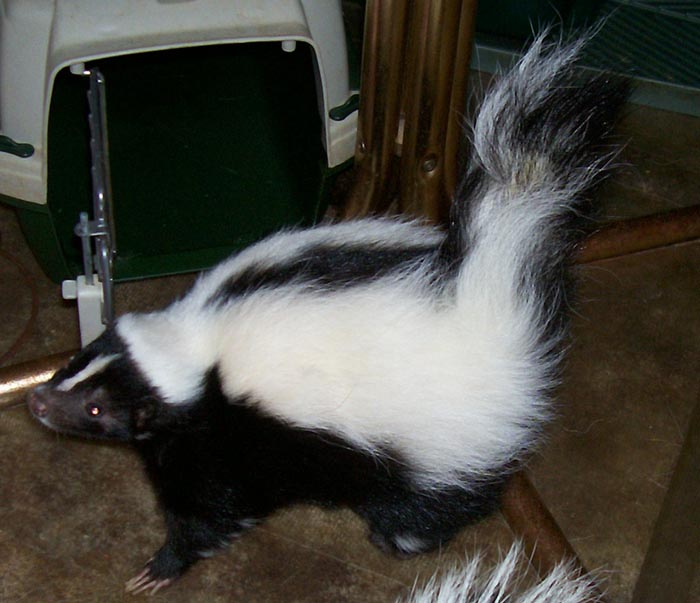 |
Photo by Deb Cipriani |
In a few months our treatment worked and she now can raise her tail again. We are still treating her with Synovi and colostrum each day for arthritis.
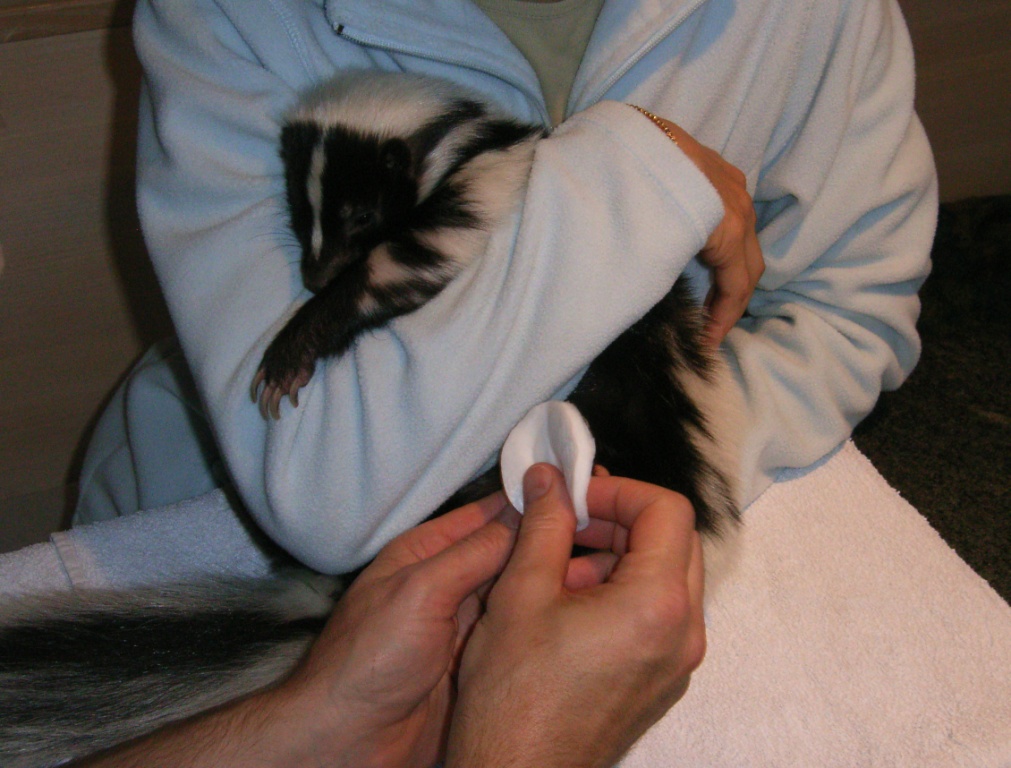 |
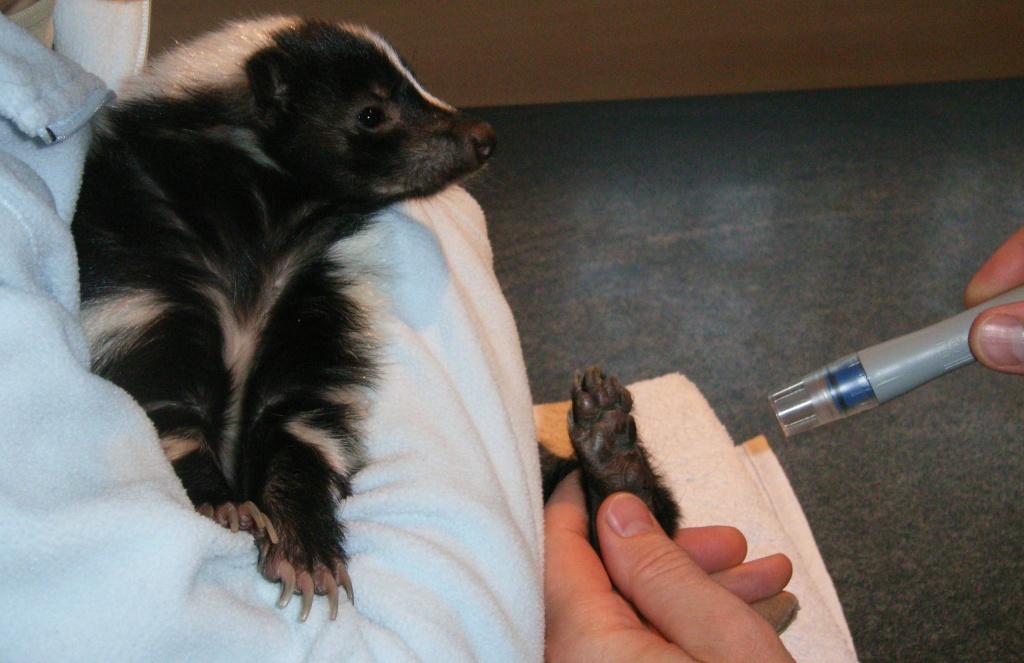 |
| Photos by Andrea Richner, Hägendorf Switzerland | |
Article by Andrea Richner
It was spring 2008: Wawassa, one of my female skunks, 2 years old, was diagnosed with diabetes. However, it took our vet several months to reach this conclusion. She was in a very poor condition and I think her little sister Nishimee was the only reason for her amazing will to live.
After some wakeful nights fearing for her life, we were able to drive her home from the clinic, armed with a blood sugar analyzer and insulin shots. They had instructed us in a crash course how to get blood out of a skunk into the indicator and to proceed alternatively with the insulin. We did a great job, really! Wawa, Hubby and I; the procedure always needed the three of us. (At times, when Linus had to work out of country Shoggi(*) was left with me, doing the unpopular job of the "needle man" while I was acting as the perfect safe haven by snuggling her up to me.
Every single day we entered the values into Wawa's excel spreadsheet. Each week we updated the chart. During summer 2008 it appeared to reach normal values twice, but just before reaching the bottom, the curve turned into the other direction. Since she received her shots, she looked and felt very well. At no time did anyone think she could be sick. Just about every day during the warm season she took a swim cross the garden pond.
All along, Google became my best friend. I did my private degree in "Natural Health Methods of Treating Diabetes". The results of my efforts can be found in the curve's description specified above.
Then, right before Christmas, unexpectedly she could not walk properly anymore. Her gait was very stiff and her steps short. The vet tried to tell me that her life soon would be over - patients with diabetes have long odds, or so he said. Half bamboozled, half shocked, I invested more time in prayers and kept on Googling for all I was worth.
But good things come to those who wait: heaven pitched me into the haystack and I found THE needle! A research paper from the University of Arizona: "Nutritional Biochemistry: Effect of raw and cooked nopal ingestion on growth and total cholesterol, lipoproteins, and blood glucose in rats". From the beginning I was tracking different research paths all over the World with moderate success. But this time I was really sure, I had to find a product with this Nopal plant inside. I found it in a French capsule from "Arkopharma" called "Arkocaps, Nopal" and started feeding it. The capsules are easy to open up and I sampled each time the highest suggested portion of the powder per weight of the skunks. I always gave her sister the same amount. According to the research paper, it should be regulating the values without any side effects - and it was!
After ten days, Wawa became somehow "compact" and then the blood values fell parallel to the stock exchange price - and fell and fell...
Miracles happen! And I will never forget that I owe God a debt of gratitude.
It was an 11 month story to get to there: Wawa waltzing across the living room, celebrating her first day without injection. And I would love to hug the whole world! That was one year ago. Since then she has been without any insulin and completely holding her blood sugar values! She still gets a little Nopal, sprinkled over her food like a condiment.
We have a list here with other Nopal winners. It is still small, but I would really love to add as much as possible to it:
Before beginning any treatment please consult your veterinarian.
We suggest that you purchase Nopal from Good Cause Wellness ®
Nopal Powder
(520) 360-5252


http://www.goodcausewellness.com/servlet/the-NOPAL-Powder/Categories
Nopal Certified Organic Juice
(800) 824-4491


www.swansonvitamins.com
If you are interested in the benefits of Nopal read about it from any of these sites:
BELOW IS WRITTEN BY ONE OF OUR MEMBERS ABOUT HER DIABETIC SKUNK
For starters, I'm not sure how high your skunk was at the time you went to the vet. Suve, when she was diagnosed, started out drinking water, just like yours did, but when we went to the vet, her blood sugar level was 330+ (that is in milligrams)....so I'm not sure what 28.3 is equal to. But, knowing that he is diabetic.....there are a number of things you can do.
#1 --what does your skunk eat?? If he has a good diet, such as veggies and all "people" food (not cat or dog food), then you should be able to swing him over to the diet that I used --you'll find that it is the same diet recommended for daibetic people. * You can follow a diet for humans with diabetes. By that I mean HIGH FIBER FOODS--LOW SUGAR or NO SUGAR FOODS.
#2 --EXERCISE is very important!!! This is whether your skunk is on injections of insulin or not. Suve started out on injections, and gradually I was able to control the diabetes with food and exercise only. After every meal, I would make her walk for at least 20 minutes around the house or outside. This will help the insulin, whether produced naturally (if he still produces any insulin on his own) or the injection get into his system and work on the food he has just eaten.
#3 --DAILY CHECKUPS This you can do at home. Going to the vet every day for bloodwork to find out where your skunks levels are is crazy. Go to your local pharmacy/drug store--ask for Glucose Urinalysis strips. The brand we have here are called DIASTIX. They are sticks with a colored tab at the end, that you swipe into the urine and check the color change, if any, against the chart on the side of the container. This will give you a better indication if your skunks levels are ok from day to day. The stick will show you how much sugar the urine has in it at it's highest point. This will let you know if your skunk is going too high at any point of the day from starting each time you collect a sample. You probably already know, but anyone with high blood sugar will urinate more frequently, as the body tries to get rid of excess sugar. Sugar spills over into the kidneys when it gets above a normal level in the body. That is why uncontrolled diabetics urinate alot, and are thirsty--they dehydrate because of excessive urinating.
(If you need me to explain the urinalysis sticks more--let me know. If your skunk uses a littlebox -- even better -- mine did and I was able to collect urine samples easily by putting one litterbox inside another of the same size litterbox, but drilled holes into the bottom of the top one to create a filter that the urine would collect into the bottom pan -- clean urine every time.)
I had a difficult time getting Suve's levels on a set schedule--in fact I never did -- she responded to the diet and exercise and was off the insulin within about a month and a half of it starting. But it could be done with patience and careful monitoring on your part.
As far as diet -- this is what Suve got in the beginning..........sugar free oatmeal (high fiber), plain puffed wheat cereal (no sugar), puffed rice cereal (no sugar), bran cereal (high fiber), GrapeNuts cereal, vegetables, yogurt made with an artificial sweetener, boiled breast of chicken, boiled turkey, cottage cheese, diabetic cookie once in ahwile for a treat, cream of rice cereal, hard boiled egg.
At the beginning, I fed the same foods every day, at the same time so I could beging to try to get the amount of insulin correct for the foods she was eating. If you have questions on this -- my suggestion to you is to research diabetes in humans -- the diet is so important. See if you can get him regulated by limiting the number of foods you give him. Granted his diet may not be the most exciting for awhile, but it will help him get regulated, which is more important. He can live a very long and healthy life with diabetes, as long as it is kept under control. You can add foods gradually once you get diabetes under control....add a food and see what it does to his levels.
Of course the skunks weight makes a difference. Being overweight doesn't help diabetes. But you can get it under control -- it is all up to you. The urine strips will also let you know if you are giving too much insulin. I lived by them for over a year with her--even though she showed no symptoms after the beginning. Suve started out with one injection a day--around 3 units, then it increased to 4 units (Suve was 10 pounds at the time), then she started needing 2 shots a day -- morning 2 units and evening 2 or 3 units -- so she stayed even throughout the day -- all at once wasn't lasting a full 24 hours day. ONCE I STARTED EXERCISE -- her need for insulin DECREASED. I dropped back to one does a day after awhile and gradually she did not require any more shots. Her body was able to produce insulin again on it's own. The daily urine strips make sure you do not overdose on insulin either. Avoid foods high in sugar and starch (starch turns to sugar) - no potatoes - but sweet potatoes are OK, limited fruit a slice of apple once or twice a week.
Feeding every 5 to 6 hrs is important. If you work, it would help to get an automatic cat feeder. They have two separate compartments with timers that you set to open. I feed Cuddles just before I leave for work and set the first timer for 5 hrs later. I get home from work in time for his next meal, but if I am going somewhere straight from work, I fill and set the second compartment. I actually bought 2 of these dishes so that if we are gone for a longer period of time, he can have 4 meals. You can get them at Pet Smart - I got mine on ebay. They come with ice packs, but they are small and melt too soon - you cannot leave meat or anything that would spoil in them. I leave only veggies in it.
Cuddles eats his skunkie delight 3 times a day and fresh veggies and some frozen veggies.
I avoid:
I give him very little of the following:
He eats:
© 2001-2020 Skunk Haven™ Skunk Rescue, Shelter, and Education, Inc.
Revised 12/31/18 (SRS)
 | ||
| Previous | SkunkHaven.Net Index | Next |